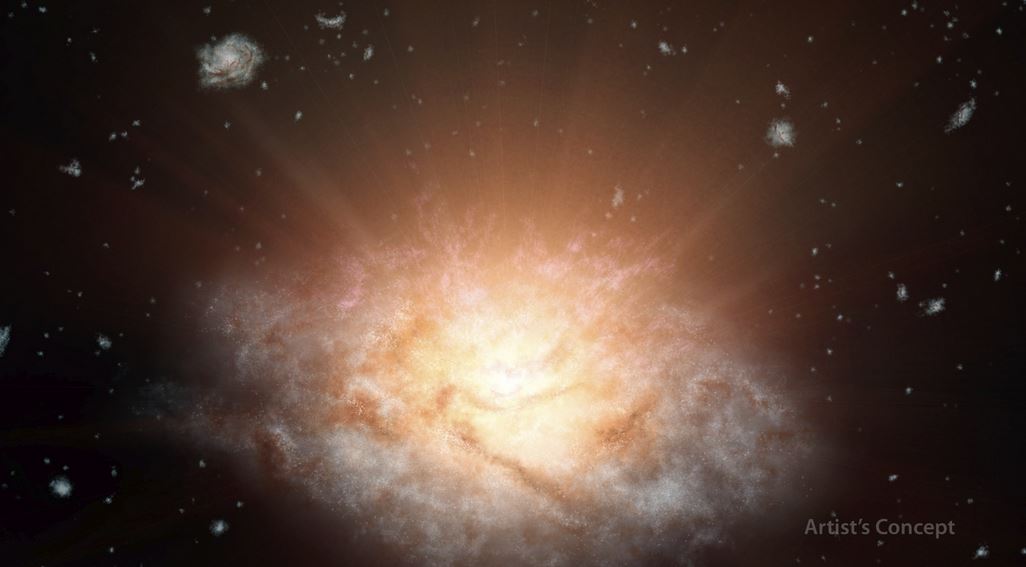Scientists have discovered the brightest galaxy in the Universe, containing over 300 trillion suns. The ELIRG (extremely luminous infrared galaxy) was detected using data from NASA’s Wide-field Infrared Survey Explorer (WISE).
The astronomers, from the US, UK, Chile, South Africa and France, wrote about their discovery in The Astrophysical Journal.
Lead author, Chao-Wei Tsai, who works at NASA’s Jet Propulsion Laboratory (JPL) in Pasadena, California, said:
“We are looking at a very intense phase of galaxy evolution. This dazzling light may be from the main growth spurt of the galaxy’s black hole.”
 An artist’s concept of the brightest galaxy found in the Universe so far. (Image: nasa.gov)
An artist’s concept of the brightest galaxy found in the Universe so far. (Image: nasa.gov)
A gigantic black hole at its belly
The luminous galaxy, called WISE J224607.57-052635.0, probably has a supermassive black hole in its centre, sucking in colossal quantities of gas, the authors believe.
Supermassive black holes draw in gas and dust into a disk around them, heating the disk to millions of degrees Celsius and blasting out high-energy, X-ray, visible and ultraviolet light.
The light is blocked by surrounding dust, which radiates infrared light as it heats up.
Supermassive black holes at the centre of galaxies are common. However, finding such a large one so ‘far back’ in the cosmos is extremely rare.
Because the galaxy’s light takes 12.5 billion years to get to us, astronomers are seeing it as it was in the far distant past. The black hole was already billions of times the mass of our own Sun when the Universe was only one-tenth of its current age of 13.8 billion years.
Why have ELIRGs black holes grown so massive?
The authors outline three reasons why an ELIRG’s black hole may have grown so massive.
Firstly, they may have been born large, i.e. the ‘seeds’ or embryonic black holes, might be much larger than thought possible.
As co-author Peter Eisenhardt, project scientist for WISE at JPL explained:
“How do you get an elephant? One way is start with a baby elephant (baby elephants are already big).”
The other two suggested reasons involve either bending or breaking the theoretical limit of black hole feeding, known as the Eddington limit. When black holes feed, gas falls in and heats up, blasting out light.
The light’s pressure actually pushes away the gas, creating a limit to how rapidly the black hole can continuously gobble up matter.
If a black hole went beyond its limit, it could theoretically balloon in size at an incredible pace. Black holes have been observed previously breaking the limit. This black hole, in order to grow so large, would have had to repeatedly break the limit.
Another possibility is that the black holes could be just bending this limit.
Slow spinning black holes may grow faster
Tsai said:
“Another way for a black hole to grow this big is for it to have gone on a sustained binge, consuming food faster than typically thought possible. This can happen if the black hole isn’t spinning that fast.”
If a black hole spins slowly enough, its meal won’t be repelled so much. Eventually, a slow-spinning black hole can devour more matter than a fast-spinning one.
Co-author Andrew Blain, who works at the University of Leicester in the United Kingdom, said:
“The massive black holes in ELIRGs could be gorging themselves on more matter for a longer period of time. It’s like winning a hot-dog-eating contest lasting hundreds of millions of years.”
The researchers say further studies are required to solve this puzzle of these super-bright galaxies. They say they have plans to better determine the masses of the central black holes.
Knowing the true weights of these objects will help scientists know more about their history.
WISE has been discovering more of these unusual galaxies in infrared images of the entire sky captured in 2010. By observing the whole sky with unprecedented sensitivity, WISE has been able to catch rare cosmic specimens that might otherwise have been missed.
The authors report on a total of 20 new ELIRGs, including this ultra-luminous one. They were not discovered earlier because they are so far away, and because dust converts their powerful visible light into an incredible outpouring of infrared light.
Tsai said:
“We found in a related study with WISE that as many as half of the most luminous galaxies only show up well in infrared light.”
Citation: “The Most Luminous Galaxies Discovered by WISE,” Chao-Wei Tsai, Stéphanie Juneau, Peter R. M. Eisenhardt, Jingwen Wu, Daniel Stern, Charles A. Beichman, Roberto J. Assef, Andrew W. Blain, Carrie R. Bridge, Dominic J. Benford, Roc M. Cutri, Roger L. Griffith, Michael F. Skrutskie, Christopher R. Gelino, Thomas H. Jarrett, Carol J. Lonsdale, Frank J. Masci, Leonidas A. Moustakas, Sara M. Petty, Deborah L. Padgett Jack Sayers, S. Adam Stanford, Edward L. Wright, Lin Yan, David T. Leisawitz, Ian S. McLean, Fengchuan Liu and Amy K. Mainzer. The Astrophysical Journal. Published 22 May, 2015. DOI: 10.1088/0004-637X/805/2/90.
Video – Brightest galaxy in the Universe found

